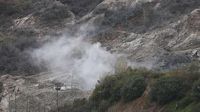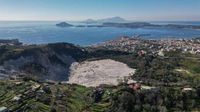Concerns are rapidly escalating in Pozzuoli, Italy, as the Phlegraean Fields supervolcano continues to unleash a wave of seismic activity, alarming residents and experts alike. For the last two years, this region has been rattled by ongoing earthquakes, culminating in a powerful quake that struck on March 13, 2025, registering a shocking magnitude of 4.6. This event is now recognized as the strongest earthquake in modern times for the area, prompting both fear and a reconsideration of the risks associated with the supervolcano known for its oppressive history.
The latest earthquake swarm began in the dead of night, adding to the unease felt by approximately half a million people living in this infamous risk zone. The earthquake's epicenter was two kilometers deep near the Via Napoli in Pozzuoli, and local infrastructure bore the brunt of the impacts; debris rained down upon streets, prompting rescue efforts from emergency services. Over 100 missions were logged by the fire department on that fateful night alone.
As of March 2025, 340 individuals from 142 households have been evacuated due to the growing risk of structural collapse. Many have taken refuge in hotels or with relatives as inspections of buildings are ongoing. So far, 670 structures have been evaluated, with several deemed uninhabitable.
The aftermath of the earthquake also saw several residents trapped in their homes due to warped door frames, forcing them to clamber out of windows in panic. Fortunately, no fatalities were reported, although 14 individuals required hospital treatment for injuries sustained during the quake.
Despite the immediate threat presented by recent seismic activity, authorities and institutions like the National Institute for Geophysics and Volcanology (INGV) have been cautious, asserting that a volcanic eruption is not considered imminent at this stage. However, this analysis is contested by some experts. Giuseppe Mastrolorenzo, a volcanologist at INGV, expresses significant alarm over the unique conditions of the current crisis. He stated, "This crisis is completely different from those in the past.” Acknowledging the increased rate of ground uplift as well as rising gas emissions, Mastrolorenzo has warned that current conditions may warrant more serious concern than officially recognized.
Since January 2024, land elevation in parts of the Phlegraean Fields has surged approximately 20 centimeters, attributed to a phenomenon known as bradyseism, stemming from underground magma movements. In recent months, the uplift rate has quadrupled, now reaching up to three centimeters per month. Coincidentally, the region has seen a dramatic increase in gas emissions, with carbon dioxide levels rising from 3,000 to 5,000 tons per day and hydrogen sulfide emissions multiplying fivefold.
Adding to the alarming conditions is the identification of new patterns in the earthquake activity. Researchers have documented what they term "burst-like swarms” of seismic activity—characterized by very short intervals between tremors—which could indicate rapidly increasing pressure within the hydrothermal systems beneath the supervolcano. These seismic sequences raise critical questions about potential volcanic activity, as past research connects this type of swarming to the early signs of eruptions.
The catastrophic potential of another eruption is staggering. Mastrolorenzo has even suggested that, should the volcano erupt, it might dwarf the devastating eruption that buried Pompeii nearly 2,000 years ago. Referencing historical eruptions, he pointed out that the Phlegraean Fields previously unleashed events of such magnitude that they annihilated all life forms within an extensive radius.
With an extensive history of eruptions—one notably occurring in 39,000 B.C. that decimated all life within an 80-kilometer radius—the threat of a supereruption looms large. The INGV currently estimates a maximum possible eruption at a cataclysmic level 4 on the volcanic explosivity index, raising fears of a historical recurrence of devastation for the densely populated region surrounding the volcano.
In light of these escalated risks, local authorities are developing contingency plans, with mass evacuation simulations already taking place. Residents have participated, reflecting a community both aware of the volatile nature of their surroundings and somewhat resigned to the uncertainties. Amidst the anxiety, municipal leaders and geophysical experts advocate for calm, emphasizing the need for preparedness while attempting to assure the public of their safety.
Meanwhile, the memories of the last significant eruption in 1538 linger in the minds of the older generation, many of whom still tell tales of the ensuing chaos and fear faced during those uncertain times. The eruption not only altered the land but also fragmented living conditions for many, a scenario unable to escape collective memory.
As citizens grapple with the near-constant threat of earthquake jolts, academic discourses persist regarding the viability of evacuation strategies. Residents are advised to remain vigilant yet calm, hoping that experts’ continuous advancements in monitoring provide a warning before any catastrophic eruption.
As the geological activity persists relentlessly, a forthcoming chapter for the Phlegraean Fields could be written in devastation or in survival. Only time will tell if the necessary precautions and modern advancements in volcanic monitoring can ensure that no one will be left behind, should the ever-evolving supervolcano decide to awaken unexpectedly.








